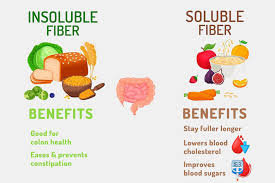Discover the key differences between soluble and insoluble fiber, their benefits for your health, and how to include them in your diet. Learn how these fibers improve digestion and overall well-being.
Why Fiber Matters
Fiber is a vital component of a healthy diet, yet many people don’t fully understand its significance. Divided into two main types—soluble and insoluble fiber—this nutrient plays a crucial role in maintaining digestive health, managing weight, and reducing the risk of chronic diseases. But what sets these two types of fiber apart? How do they benefit your body differently?
This article dives deep into the distinctions between soluble and insoluble fiber, exploring their unique roles, health benefits, and how you can incorporate them into your daily meals.
What Is Soluble Fiber?
Soluble fiber dissolves in water to form a gel-like substance in the digestive tract. Found in various fruits, vegetables, and grains, it offers several health benefits:
Sources of Soluble Fiber
- Fruits: Apples, oranges, berries, and bananas.
- Vegetables: Carrots, broccoli, and sweet potatoes.
- Legumes: Lentils, chickpeas, and beans.
- Grains: Oats, barley, and psyllium.
Benefits of Soluble Fiber
- Improves Heart Health: By binding with cholesterol, soluble fiber helps reduce LDL (bad cholesterol) levels, lowering the risk of heart disease.
- Regulates Blood Sugar: It slows down digestion and glucose absorption, making it an excellent choice for people with diabetes or those looking to prevent blood sugar spikes.
- Promotes Satiety: The gel-like consistency helps you feel full longer, supporting weight management.
What Is Insoluble Fiber?
Unlike soluble fiber, insoluble fiber does not dissolve in water. Instead, it adds bulk to stool and helps food move through the digestive system, preventing constipation.

Sources of Insoluble Fiber
- Whole Grains: Brown rice, whole wheat, and bran.
- Vegetables: Cauliflower, green beans, and zucchini.
- Nuts and Seeds: Almonds, sunflower seeds, and flaxseeds.
- Skins of Fruits and Vegetables: Such as potato and apple peels.
Benefits of Insoluble Fiber
- Supports Digestive Health: By adding bulk to stool, insoluble fiber helps prevent constipation and promotes regular bowel movements.
- Reduces Risk of Diverticular Disease: It keeps the digestive tract healthy and reduces the likelihood of developing conditions like diverticulitis.
- Helps Maintain a Healthy Weight: Similar to soluble fiber, its role in promoting satiety can aid in weight management.
Soluble vs. Insoluble Fiber: Key Differences
| Feature | Soluble Fiber | Insoluble Fiber |
|---|---|---|
| Water Solubility | Dissolves in water | Does not dissolve in water |
| Primary Function | Forms gel-like substance for digestion | Adds bulk to stool and aids transit |
| Health Benefits | Reduces cholesterol, controls blood sugar | Promotes regularity, prevents constipation |
| Sources | Oats, beans, fruits | Whole grains, nuts, vegetables |
Both types of fiber are essential for overall health, working together to improve digestion and protect against disease.
How Much Fiber Do You Need Daily?
The recommended daily intake of fiber varies by age and gender:
- Men: 30-38 grams.
- Women: 21-25 grams.
A balanced diet that includes both soluble and insoluble fiber can help you meet these goals while providing comprehensive health benefits.
Tips to Add More Fiber to Your Diet
- Start Your Day Right: Opt for oatmeal topped with fruits and nuts to pack both types of fiber into your breakfast.
- Snack Smart: Choose fresh fruits, raw vegetables, or a handful of nuts instead of processed snacks.
- Go Whole: Replace refined grains with whole-grain options like brown rice and whole wheat bread.
- Incorporate Legumes: Add lentils or beans to soups, stews, and salads for an extra fiber boost.
- Hydrate: Drink plenty of water when increasing your fiber intake to prevent digestive discomfort.
The Health Impacts of Fiber Deficiency
A lack of fiber in the diet can lead to various health issues:
- Constipation: Insufficient insoluble fiber may slow digestion.
- Weight Gain: Without the satiety provided by fiber, overeating becomes more likely.
- Increased Risk of Chronic Diseases: Low fiber intake is linked to a higher risk of heart disease, type 2 diabetes, and certain cancers.
Why Balance Matters
Both soluble and insoluble fiber are essential for optimal health. While soluble fiber helps regulate blood sugar and cholesterol, insoluble fiber ensures a smooth digestive process. By including a variety of fiber-rich foods in your diet, you can enjoy a healthier gut, improved heart health, and better weight management.
FAQs: Common Questions About Fiber
1. Can you get too much fiber?
Yes, excessive fiber intake can lead to bloating, gas, and stomach cramps. Gradually increase your fiber intake and drink plenty of water to avoid discomfort.
2. Is one type of fiber better than the other?
Both soluble and insoluble fiber offer unique benefits. A healthy diet should include a balance of both to ensure comprehensive health benefits.
3. Can fiber help with weight loss?
Yes, fiber promotes satiety, helping you feel full longer and reducing the likelihood of overeating.
4. Are fiber supplements effective?
Fiber supplements can be helpful, but it’s best to get fiber from whole foods, as they provide additional nutrients and health benefits.
5. What’s the best time to consume fiber?
Fiber can be consumed throughout the day. Including it in every meal ensures consistent benefits.
By understanding the differences between soluble and insoluble fiber, you can make informed dietary choices that support your overall health and well-being. Start incorporating more fiber into your diet today for a healthier tomorrow!